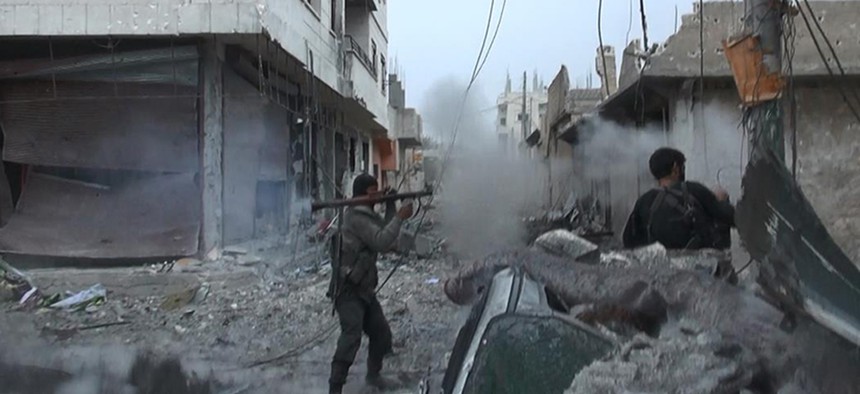
This undated file photo posted on Monday, Nov. 4, 2014 by the Raqqa Media Office of the Islamic State group, a militant extremist group, shows fighting in Kobani, Syria. AP Photo/Raqqa Media Office
How ISIS Territory Has Changed Since the US Bombing Campaign Began
An animated depiction of a stalemate.
In an address to the nation this time last year, President Barack Obama outlined a plan to “degrade and ultimately destroy” ISIS. It was the eve of the 13th anniversary of the September 11 attacks, and at that point the United States had already been bombing ISIS in Iraq for about a month, having intervened as the group menaced the capital of Iraqi Kurdistan and threatened to wipe out the Yazidis, a religious minority. In late August and early September, the group beheaded the American journalists James Foley and Steven Sotloff in the Syrian desert, helping prompt an expansion of U.S. airstrikes into Syria.
Obama said in his speech that the United States had already conducted 150 successful airstrikes against ISIS in Iraq. A year later, the United States military and its allies have conducted 6,700 airstrikes across Iraq and Syria, sent more than 3,000 U.S. troops to Iraq, and trained thousands more Iraqi troops as well as a handful of Syrian fighters. Here’s one critical indicator of how that campaign, Operation Inherent Resolve, is progressing: a look at how ISIS territory has changed in the year since the U.S.-led military campaign began:

Over the past year of U.S. and allied airstrikes, combined with ground offensives by local forces, the Islamic State has lost territory in some areas and gained it in others. In the maps above, produced by the Institute for the Study of War, the black lines represent areas where ISIS holds its tightest control—encompassing roads and several large population centers. Over time, the black splotches recede in places, namely northwestern Syria along the border with Turkey, outside Baghdad, and near the Iraqi city of Tikrit; and expand in others, namely in central Syria near Palmyra, and in Iraq near Ramadi, the capital of Anbar province.
(See also from June 2015: This Is How Little the US-Led Air War Against ISIS Has Achieved)
The maps also show that ISIS exerts varying degrees of control over the territories where it operates. As Jennifer Cafarella, an analyst at ISW, explained to me last year:
The attack zones are the most straightforward and are meant to depict those areas in which ISIS has participated in or perpetrated armed clashes or kinetic engagements (such as IEDs). Support zones are areas in which ISIS enjoys freedom of movement and from which such attacks are often staged: they are areas in which ISIS does not necessarily possess defensible control, but in which ISIS forces can nonetheless travel and operate with relatively low risk. Control zones, then, are areas in which we have assessed ISIS to have a larger degree of defensible control ... in which a counter-ISIS force would be faced with serious ISIS resistance.
This does not add up to the territory “the size of Belgium” that has been attributed to ISIS, but rather to a tattered patchwork of infrastructure and cities—which is also, perhaps, a fair way to describe state control in parts of Iraq and certainly Syria. There are different estimates about whether the group has gained or lost territory overall in the past year. The U.S. Defense Department has saidthat as of April, “ISIL can no longer operate freely in roughly 25 to 30 percent of the populated areas of Iraqi territory where it once could. … ISIL’s area of influence in Syria remains largely unchanged.” But the Pentagon’s inspector general is investigating claims that such reports have been skewed to offer a better picture of the military campaign’s progress, and The Daily Beast has reported that the official account leaves out important territorial gains ISIS has made. The intelligence company Jane’s estimated in July that ISIS had lost 9.4 percent of its territory in the first half of 2015; analysts at ISW use different baselines for how much territory ISIS had to begin with, and the institution doesn’t give percentage estimates of territory gained or lost.
It’s easier and perhaps more informative to focus on the kind of territory ISIS has gained and lost over the past year. As John Ford, a reserve captain in the U.S. Army’s Judge Advocate General Corps, wrote recently for War on the Rocks, all of this adds up to “four major areas of territorial change: ISIL losses near Baghdad, in the Kurdish areas of Iraq, and along the Turkish border with Syria, and ISIL gains in and around Palmyra.” Here’s the pattern he identified:
ISIL has been able to thrive in areas with a majority Arab Sunni population but has failed to take hold in areas where Sunni Arabs are the minority or where effective rival ground forces could oppose them. … Taken in this light, ISIL appears to have essentially traded holdings in Kurdistan and near Baghdad that were hard for it to maintain for holdings in central Syria that will be much easier for it to maintain.
This month, Martin Dempsey, the chairman of the Joint Chiefs of Staff, called the fight against ISIS “tactically stalemated” with no “dramatic gains on either side,” predicting it would take “a decade or more to resolve” the problems that led to ISIS’s rise. This is the difference a year made.




